Friday, June 16, 2006
Æ29, Augusta in Cilicia, Valerian, SNG von Aulock 5538
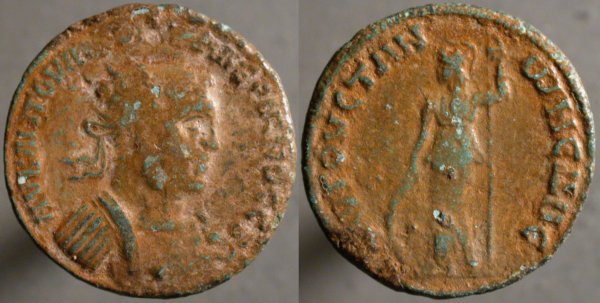
AV KAI ΠOV ΛI[K O]VAΛEPIANO CE, Laureate cuirassed bust right | AVΓOCTAN_ωN E ΔΛC, Athena standing facing, looking left, resting right hand on shield, holding spear with left.
I like to know something about where a coin is from, to help me understand its place in the ancient world. That's a problem here because Augusta is such a commonly-used word, a title given to an emperor's wife or other female relative.
(The worst of all is Metropolis in Ionia which confuses search engines due to the common use of phrases like "Ephesus was the metropolis of Ionia" and "Miletus, the metropolis of Ionia". Also Superman and Fritz Lang.)
Thursday, June 15, 2006
Æ counterfeit, Gallienus, "Rome", like Göbl 744b
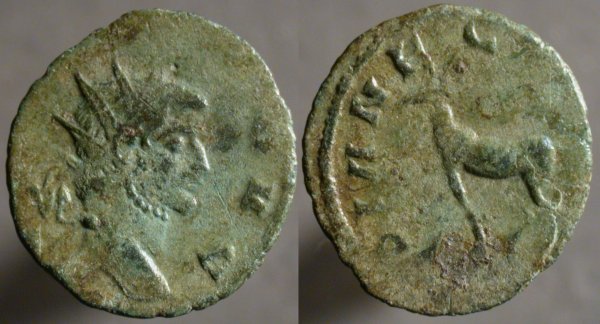
[GALLIENVS] AVG, Radiate head right | DIANH C[ONS AVG], Stag walking left. Exergue obscure.
Ancient counterfeits make an interesting addition to a collection. They were a part of the ancient economy, probably created a few years after the coin they imitate, soon enough that the coin wouldn't attract much attention but long enough that the victim was unlikely to have an official version in hand to compare with.
Warren Esty's excellent site on Ancient Imitations of Roman Coins.
Wednesday, June 14, 2006
AR denarius, Lucius Sentius C. f., Roman Republic, 101 BCE, Crawford 325/1b
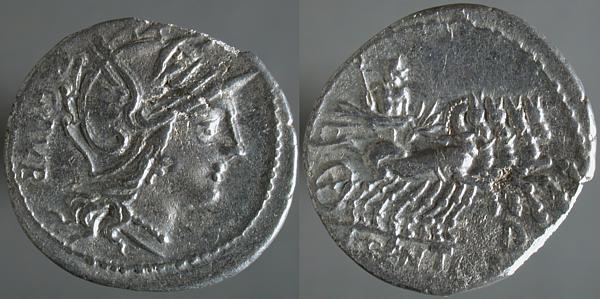
Head of Roma right. ARG·PVB behind | Jupiter in quadriga right with thunderbolt and scepter, D below horses. L·SENTI·C·F in exergue.
No history I can find on Lucius Sentius, issuing moneyor of this coin. ARG PVB probably declares that he was explicitly ordered by the Senate, using silver that they supplied, unlike the coins issued by the members of the annually-appointed triumvirate.
Tuesday, June 13, 2006
“Actions Speak Louder”
Apparent bad faith from publisher Hachette Filipacchi in use of photos stolen from Michael Yon.
Æ24, Magnesia ad Meandrum in Ionia, Salonina, cf. SNG Cop 897...
(Otacilia Severa)
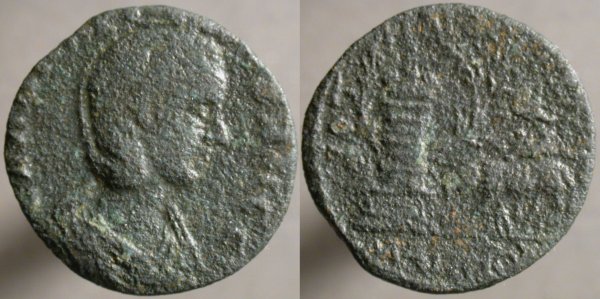
C[AΩNCP]V C[OΛONH] CE, Diademed draped bust right | [...], Ram approaching a flaming altar, olive trees spring from the sides of altar. [MAΓNHTΩN] (or similar) in exergue.
My first coin from this city. Like other cities named Magnesia, the name Magnesia ad Meandrum refers to lodestone or other naturally-occuring magnetic material. Meandrum, the river on which the city was located, was a young river with many turnings and has lent its name to a decorative pattern certainly familiar to subscribers to The Celator, a popular magazine about ancient and medieval coins and antiquities, which has featured a meander pattern on its cover for years.

C[AΩNCP]V C[OΛONH] CE, Diademed draped bust right | [...], Ram approaching a flaming altar, olive trees spring from the sides of altar. [MAΓNHTΩN] (or similar) in exergue.
My first coin from this city. Like other cities named Magnesia, the name Magnesia ad Meandrum refers to lodestone or other naturally-occuring magnetic material. Meandrum, the river on which the city was located, was a young river with many turnings and has lent its name to a decorative pattern certainly familiar to subscribers to The Celator, a popular magazine about ancient and medieval coins and antiquities, which has featured a meander pattern on its cover for years.
Monday, June 12, 2006
Billon antoninianus, Gallienus, Rome, Göbl 25v
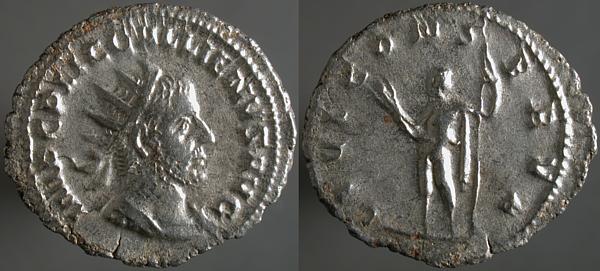
IMP C P LIC GALLIENVS AVG, Radiate cuirassed bust right | IOVI CONSERVA, Jove standing left, holding thunderbolt in right hand and scepter in left.
Here an early issue for Gallienus, with a higher silver content than would be seen again, noting Jove, king of the gods, as protector. Much the same formula would be used at the end of the reign in the legends of the “zoo series”

